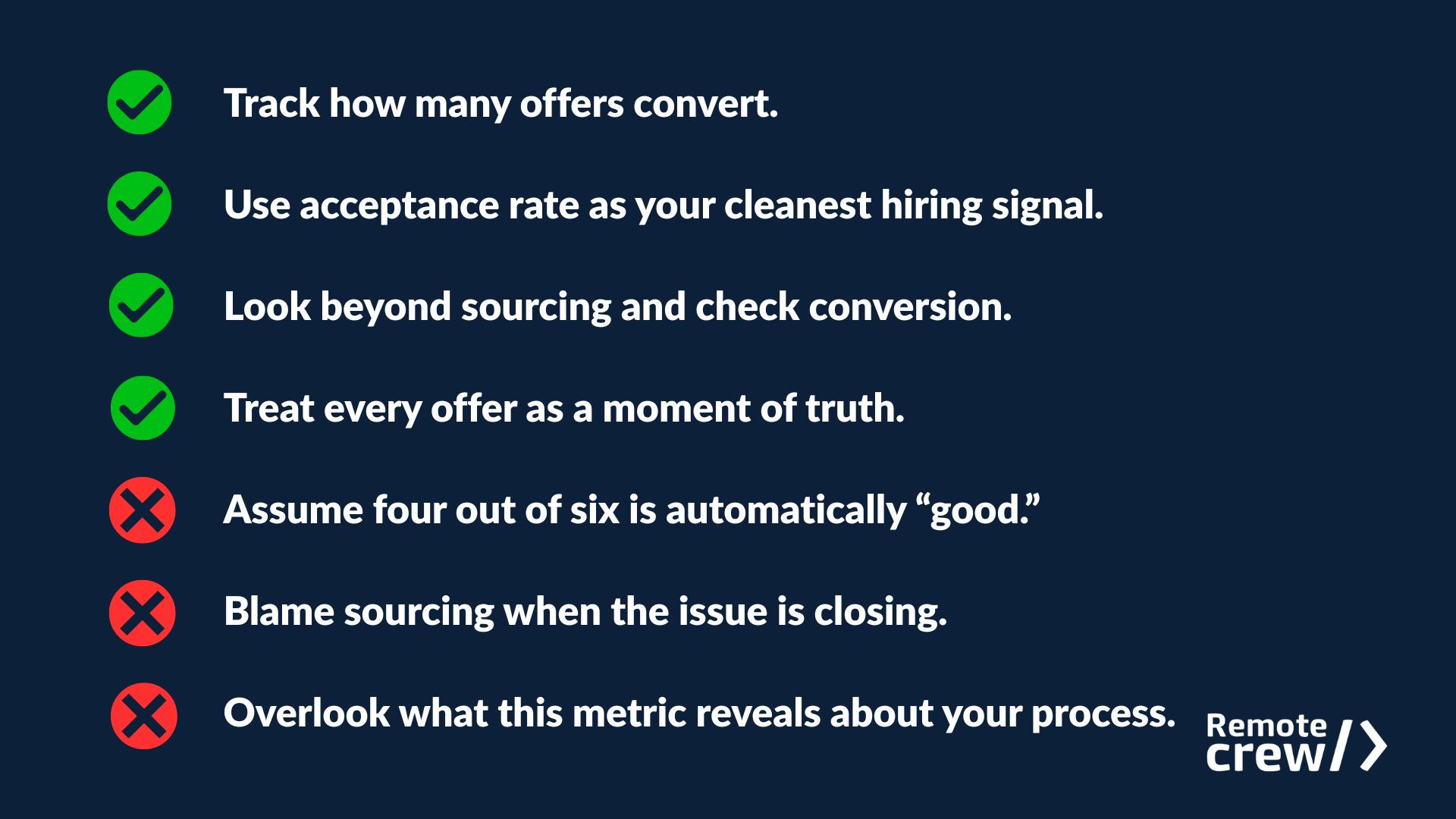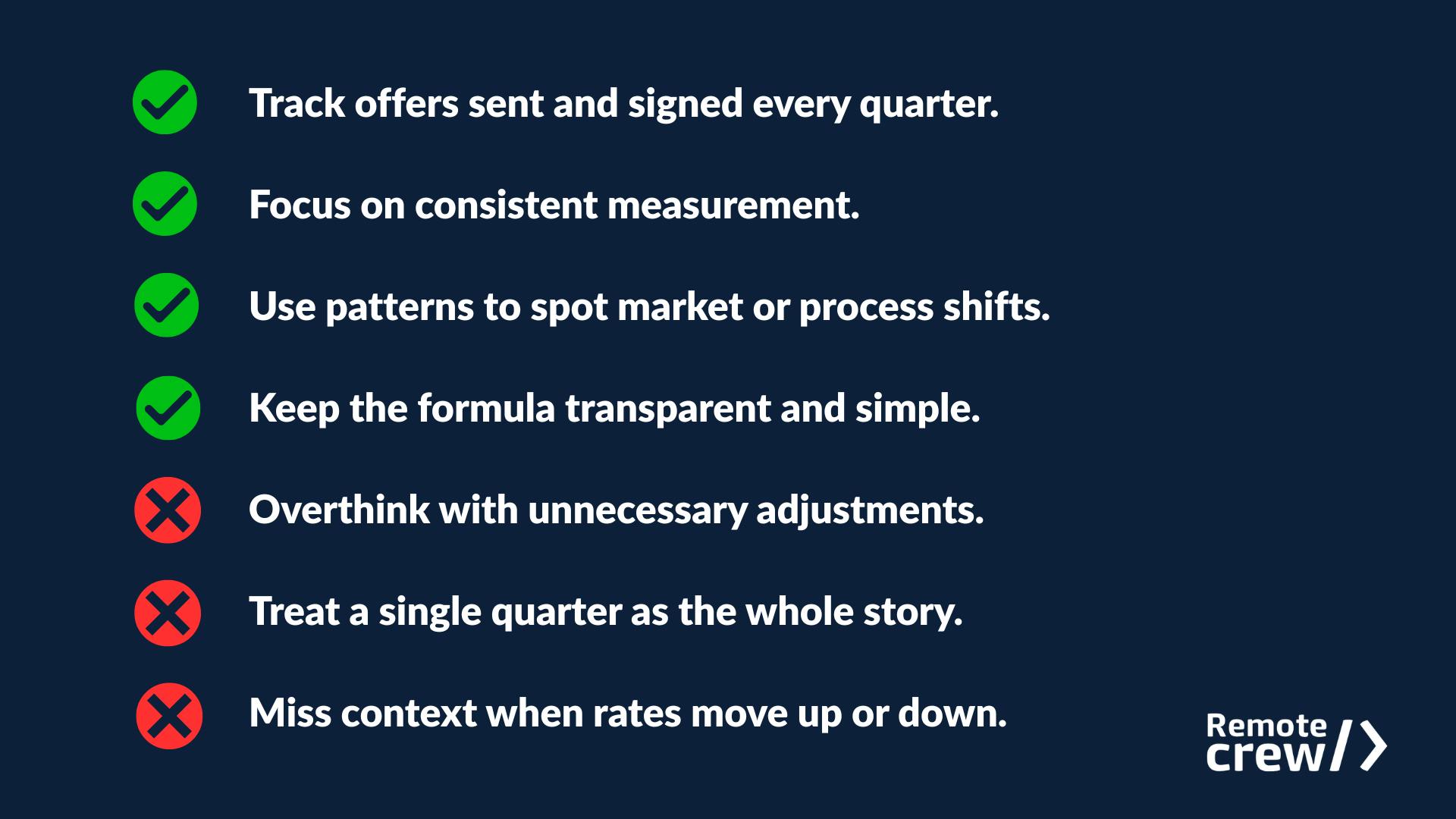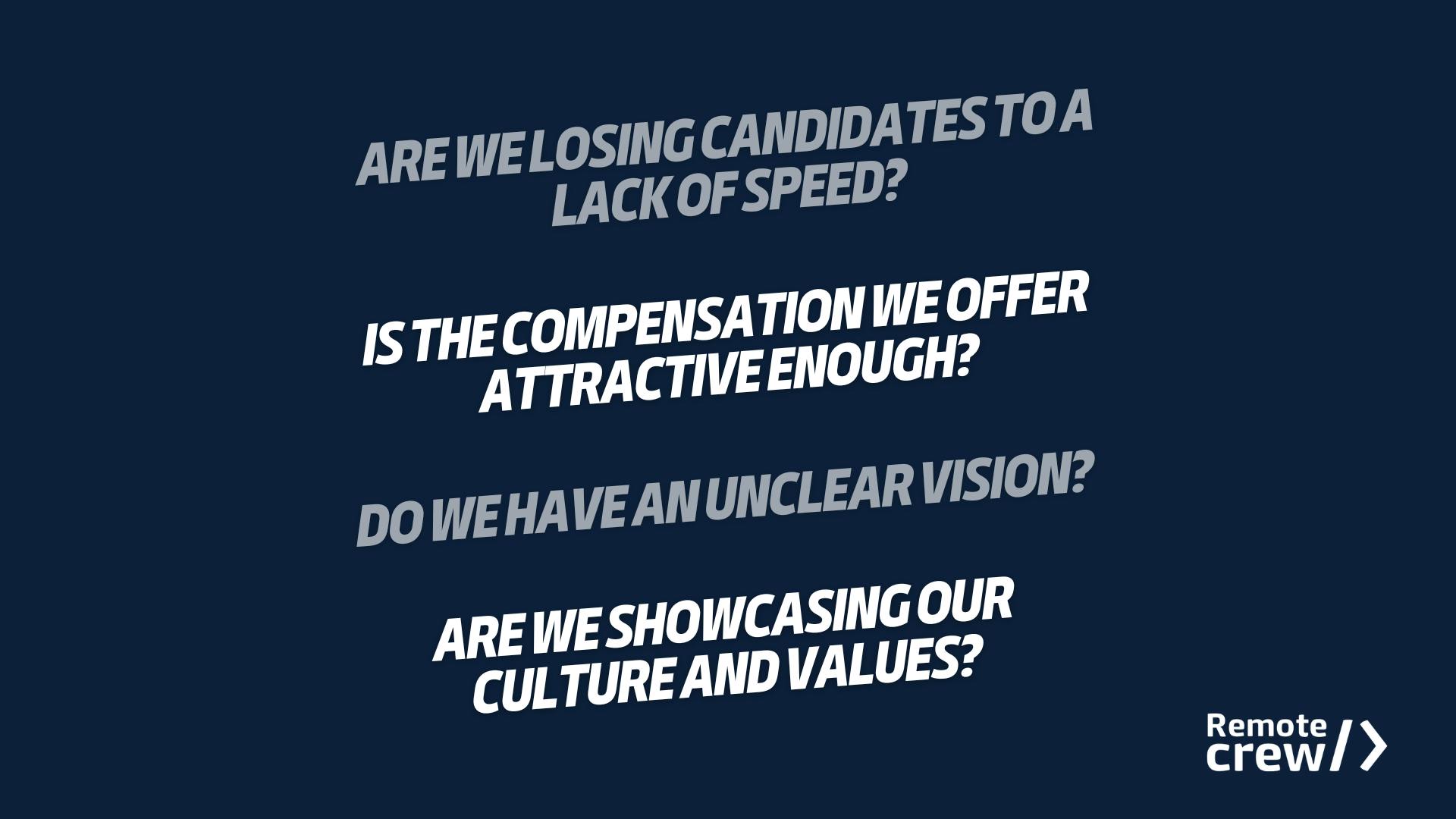A founder I spoke with last week was struggling with how to calculate offer acceptance rates.
I was told they had extended six offers over the past two months.
Four had been accepted and two had been turned down.
They wanted to know if that meant they were doing well or if it pointed to something broken in their hiring process.
This is where I believe the offer acceptance rate becomes the “cleanest signal” you can track in recruiting.
At Remote Crew, I spend a lot of time looking at this number with clients. Startups often believe their hiring challenges are about sourcing, but many times the gap is in the conversion step.
I see offers going out, but they don’t get signed. You can solve sourcing problems with better pipelines.
Offer acceptance problems reveal something deeper about three things:
- Positioning
- Timing
- Candidate experiences
How I Calculate Offer Acceptance Rates
My formula for how to calculate an offer acceptance rate is actually very straightforward.
Here’s what I’m using (along with the rest of my team):
Offer Acceptance Rate = (Number of Offers Accepted ÷ Number of Offers Extended) × 100
No special adjustments, that’s it. If you extend 10 offers and 8 are accepted, your acceptance rate is 80 percent.
This is a direct signal with simple math that’s easy to compare over time.
I like metrics that tell a story quickly. This one certainly does! It tells you if the people you want to hire actually want to join you.

Here’s My View On Acceptance Rate Benchmarks
When I share acceptance rate data with founders, their first question is always: what does good look like?
From what I’ve seen across dozens of startups, an ideal benchmark sits between 80 and 90 percent.
That range reflects healthy hiring, and it’s what you should aim for.
If you’re hitting 80 to 90 percent, you are winning most of the candidates you want, while still facing enough pushback to know you are competing in the market.
If your number is below 70 percent, I believe you likely have a structural issue.
Sometimes, it’ll come down to:
- Compensation
- Speed of process
- Clarity of pitch
One thing I know for sure is that high decline rates are never random.
If your number is above 95 percent, it might sound great.
In reality, it may mean you are underpricing roles or not being ambitious enough in who you target.
I’ve always found that great candidates have choices, and an overly perfect rate is a warning flag you shouldn’t ignore.
Why This Metric Shapes My Work With Clients
I look at the acceptance rate as a pressure test on the entire recruiting funnel.
We know sourcing is strong when the right people show up, and the assessment is solid if candidates stay engaged.
Closing is working when offers land. It’s really that simple.
Here’s how I see it play out:
- High sourcing numbers with weak acceptance are generally down to a broken pitch.
- Fast funnel but poor acceptance is an indication of rushed decision-making.
- Great acceptance with a slow funnel suggests missed growth targets.
The clients I start working with all have different bottlenecks in the beginning.
When I’m studying the acceptance rate, it helps me zero in on which part of the process deserves the most attention.
My Story Helping A Client Achieve A Higher Acceptance Rate
One of our clients had extended 12 offers in a quarter, and only 7 were accepted.
The founder thought the issue was compensation.
After we dug in, we discovered the real gap was actually communication speed.
I found that their candidates were waiting two weeks between the final interview and the offer letter.
In that time, other companies were closing them.
We acted immediately and cut the delay down to 48 hours.
In the next quarter, they saw a higher acceptance rate.
It’s worth noting that we made no changes to the compensation or the roles themselves.
My team and I focused on tightening up the candidate experience.
How I Coach Founders To Use The Formula
I tell founders to keep the math ridiculously simple.
You need to track the raw number of offers you extend and the raw number accepted.

Don’t start complicating it with special categories or adjustments.
I want you to focus on consistency because that matters way more than nuance here.
When you calculate it each quarter, you’ll start to see patterns. For example:
- Quarter 1: 6 offers, 5 accepted (83%)
- Quarter 2: 10 offers, 7 accepted (70%)
- Quarter 3: 8 offers, 7 accepted (88%)
From that, you can tell something slipped in Quarter 2.
It might be an issue like a new competitor entered your space, or maybe your interview loop slowed down.
The data won’t answer everything, but it’s going to point you in the right direction.
How This Shapes Remote Hiring Specifically
Candidates want a little clarity on how distributed teams operate, what the culture feels like, and how collaboration works across time zones.
If you are not ready with strong answers, you will inevitably lose people late in the funnel.
I’ve seen founders underestimate this part.
They think remote talent only cares about flexibility. In reality, top engineers want to know they’ll be supported, that communication won’t be a nightmare, and that the team is aligned.
When you can’t show that, your acceptance rate drops.
The startups I work with that do best in remote hiring invest early in documenting culture.
They share details on tools, communication cadence, and expectations.
This turns candidate uncertainty into confidence.
My Framework For Improving Acceptance Rate
Here’s what I tell founders to focus on when they want to lift their numbers:
- Sharpen the offer itself.
- Move fast at the close.
- Communicate clearly during every step.
Speed is going to matter more than you would expect.
A candidate waiting days or weeks for paperwork is a candidate you might lose.
Likewise, vague communication erodes trust.
The more clarity you give, the greater chance you have of a candidate saying yes.
What You Should Do After Calculating
Once you run the formula and know your number, I want you to run diagnostics. You need to ask yourself:
- Are we losing candidates to a lack of speed?
- Is the compensation we offer attractive enough?
- Do we have an unclear vision?
- Are we showcasing our culture and values?
You should really ask yourself some critical questions.

The answers won’t always be obvious, but the questions will definitely narrow your focus.
You can then run small experiments like shortening your timeline and reframing your pitch.
Adjust your comp bands. Watch how your acceptance rate responds.
Acceptance Rate Is An Underused Recruiting Metric
I see “acceptance rate” as one of the most underused recruiting metrics by startups.
Founders obsess over inbound applications or sourcing volume, but they ignore the point that truly matters: did the candidate sign?
Every offer is a moment of truth.
If you extend an offer and it is accepted, that’s validation of your entire process.
If it’s declined, it’s a signal you need to improve.
I want you to:
- Keep the math simple.
- Track the number each quarter.
- Use it as a guide to refine your hiring engine.
Over time, you’ll see the compounding effect. Higher acceptance rates mean faster team growth, and faster growth means you reach your milestones earlier.
That’s why I spend so much time on this metric with our clients at Remote Crew.
It shows how well you are building trust with the people you want to work with.
Do you need remote technology recruitment services for your startup? I help startups hire the best remote talent. You can start hiring with Remote Crew today.
Tech hiring insights in your inbox
From engineers to engineers: helping founders and engineering leaders hire technical talent.
We will only ever send you relevant content. Unsubscribe anytime.






